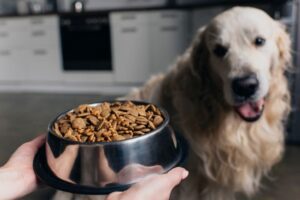Key Takeaways:
- Calorie needs for dogs vary depending on their age, size, activity level, and overall health.
- Consulting with a veterinarian is crucial to determine the appropriate daily calorie intake for your dog.
- Overfeeding can lead to obesity and related health issues, while underfeeding can result in malnutrition and weakness.
- A balanced diet that includes high-quality protein, fats, carbohydrates, vitamins, and minerals is essential for a dog's overall well-being.
- Regular monitoring of your dog's weight and adjusting their calorie intake accordingly is important to maintain a healthy body condition.
Are you a dog owner who wants to ensure that your furry friend stays healthy and happy? Well, understanding how many calories your dog should eat per day is a crucial piece of information that can make all the difference. By delving into this subject, you will gain valuable insight into providing the best nutrition for your canine companion. Whether you have a playful Labrador or a small Chihuahua, knowing their daily caloric needs can help prevent obesity and keep them in tip-top shape. So, let's dive right in and explore the world of doggie nutrition together!
Recommended Daily Calorie Intake for Dogs
Why is it important to feed dogs the right amount of calories?
Feeding your dog the right amount of calories is essential for their overall health and well-being. Just like humans, dogs need a balanced diet to stay healthy and maintain a proper weight. Feeding them too many or too few calories can lead to various health problems.
When dogs consume excess calories, they can become overweight or obese, which puts them at risk for conditions like diabetes, heart disease, and joint problems. On the other hand, if they don't get enough calories, they may become malnourished and weak.
Determining your dog's ideal calorie needs
To determine how many calories your dog needs each day, you'll need to consider factors such as their age, size, activity level, and overall health. Puppies and younger dogs generally require more calories than adult or senior dogs.
Your veterinarian can help you determine the appropriate calorie intake for your dog based on these factors. They may use formulas or guidelines provided by veterinary nutritionists to calculate the exact number of calories needed.
The Importance of Feeding Dogs the Right Amount of Calories
Factors that affect a dog's calorie requirements
- Age: Puppies have higher energy needs compared to adult or senior dogs.
- Size: Smaller breeds tend to have faster metabolisms and may require more calories per pound compared to larger breeds.
- Activity level: Highly active dogs such as working or sporting breeds may need more calories than sedentary ones.
- Overall health: Dogs with certain medical conditions like thyroid issues or diabetes may have specific dietary requirements that affect their calorie intake.
The negative effects of overfeeding or underfeeding dogs
Overfeeding your dog can lead to obesity, which can cause a range of health problems such as joint issues, heart disease, and diabetes. Obesity can also shorten a dog's lifespan and reduce their quality of life.
On the other hand, underfeeding your dog can result in malnutrition and weakness. They may not get the necessary nutrients they need for optimal growth and development. Undernourished dogs may have a weakened immune system and be more susceptible to illnesses.
Signs that Your Dog Isn't Getting Enough Calories
If your dog isn't getting enough calories, you may notice signs such as:
- Weight loss or inability to gain weight
- Lack of energy or lethargy
- Dull coat or hair loss
- Poor muscle tone
- Frequent illnesses or slow healing wounds
If you notice any of these signs, it's important to consult with your veterinarian to determine if your dog's calorie intake needs adjustment.
Guidelines and Resources to Calculate Your Dog's Calorie Needs Accurately
To calculate your dog's calorie needs accurately, it's best to consult with a veterinarian who specializes in nutrition. They can consider all the factors mentioned earlier and provide you with specific guidelines tailored to your dog's needs.
You can also find online resources and calculators that estimate calorie requirements based on breed, weight, age, and activity level. However, keep in mind that these calculators are general estimates and may not be as accurate as personalized recommendations from a veterinary professional.
The Negative Effects of Overfeeding or Underfeeding Dogs
Overfeeding or underfeeding dogs can have detrimental effects on their health and well-being. When dogs are overfed, they can become overweight or obese, which puts them at risk for various health problems such as diabetes, heart disease, and joint issues. Additionally, excess weight can decrease a dog's energy levels and overall quality of life. On the other hand, underfeeding dogs deprives them of essential nutrients and calories needed for proper growth and development. This can lead to malnutrition, weakened immune system, stunted growth, and poor muscle tone. It is important to find the right balance in feeding our furry friends to ensure their optimal health.
Obesity: A Growing Concern
One of the most common negative effects of overfeeding dogs is obesity. Just like humans, when dogs consume more calories than they burn off through exercise and daily activities, they gain weight. Obesity in dogs not only affects their physical appearance but also puts strain on their joints and organs. It can lead to arthritis, respiratory problems, high blood pressure, and even certain types of cancer. To prevent obesity in dogs, it is crucial to feed them a balanced diet with appropriate portion sizes and engage them in regular exercise.
The Dangers of Malnutrition
Underfeeding dogs can result in malnutrition, which occurs when they do not receive enough essential nutrients to support their bodily functions. This can happen due to insufficient food intake or an unbalanced diet lacking in key nutrients like proteins, vitamins, and minerals. Malnourished dogs may experience slow growth rates, weakened immune systems making them more susceptible to infections and diseases, dull coat or hair loss, muscle wasting, and overall poor health. It is vital for dog owners to provide their pets with adequate nutrition by following recommended feeding guidelines.
Common Signs of Overfeeding or Underfeeding Dogs
To determine if your dog is being overfed or underfed, it is important to be aware of certain signs. Some common signs of overfeeding include excessive weight gain, difficulty in breathing or moving, lethargy, and a lack of appetite. On the other hand, signs of underfeeding may include rapid weight loss, visible ribs or bones, a dull coat, weakness, and increased susceptibility to illnesses. If you notice any of these signs in your dog, it is recommended to consult with a veterinarian who can provide guidance on proper feeding habits.
Signs that Your Dog Isn't Getting Enough Calories
Determining if your dog isn't getting enough calories is crucial for their overall health and energy levels. Some signs that indicate insufficient calorie intake include weight loss despite regular feeding, decreased activity levels and playfulness, constant hunger or begging for food even after meals, and a noticeable decrease in muscle mass. It is important to address these signs promptly by adjusting their diet to ensure they receive adequate calories for their size, age, and activity level.
The Importance of Accurate Calorie Calculation
Accurately calculating your dog's calorie needs is essential for maintaining their optimal health. Factors such as age, breed, size, activity level, and overall health condition should be taken into consideration when determining the appropriate calorie intake for your furry friend. There are various guidelines and resources available to help pet owners calculate their dog's calorie needs accurately. These resources often provide formulas based on the dog's weight and activity level to determine the ideal daily caloric intake.
Guidelines and Resources for Calculating Dog's Calorie Needs
One popular method for calculating a dog's calorie needs is using the Resting Energy Requirement (RER) formula. This formula takes into account the dog's weight in kilograms and multiplies it by a specific factor based on their activity level. Another helpful resource is consulting with a veterinarian who can provide personalized guidance and recommendations tailored to your dog's specific needs. Additionally, there are online calculators and mobile applications available that can assist in determining the appropriate calorie intake for your dog. By accurately calculating their calorie needs, you can ensure that your furry companion receives the right amount of nutrition to thrive.
Overall, understanding the negative effects of overfeeding or underfeeding dogs is crucial for responsible pet ownership. By being aware of the signs and utilizing accurate guidelines and resources for calculating their calorie needs, we can ensure that our beloved canine companions lead healthy and fulfilling lives.
Understanding Your Dog's Calorie Needs
Factors Affecting Calorie Requirements
To accurately calculate your dog's calorie needs, it is important to consider various factors that can influence their energy requirements. These factors include the dog's age, breed, size, activity level, and overall health condition. For example, a young and active Labrador Retriever will require more calories compared to an older and sedentary Chihuahua. Additionally, pregnant or nursing dogs may have higher calorie needs due to the energy demands of pregnancy and lactation.
Calculating Daily Calorie Intake
Once you have identified the relevant factors for your dog, you can use a simple formula to estimate their daily calorie intake. The formula typically involves multiplying the dog's weight in kilograms by a specific factor based on their activity level. For example, a moderately active dog may require around 1.5 times their body weight in calories per day.
Example Calculation:
Let's say you have a 20-kilogram Beagle who has a moderate activity level. To calculate their daily calorie needs using the formula mentioned above:
Calories per day = 20 kg (weight) x 1.5 (activity factor) = 30 calories
It is important to note that this is just an estimate and individual variations may occur. Consulting with your veterinarian can provide more accurate guidance tailored specifically to your dog's needs.
Additional Considerations
While calculating your dog's calorie needs is essential for maintaining their overall health and weight, it is equally important to ensure they receive balanced nutrition from high-quality food sources. Feeding them appropriate portions of protein-rich food along with essential vitamins and minerals will support their overall well-being.
In addition to monitoring caloric intake, regular exercise plays a crucial role in keeping your dog fit and healthy. Engaging in activities such as daily walks, playtime, or interactive games can help burn excess calories and prevent obesity.
Remember, understanding your dog's calorie needs is a vital step towards providing them with the right amount of food and ensuring their overall health and happiness.
In conclusion, the number of calories a dog should eat per day depends on their size, age, and activity level. It is important to consult with a veterinarian to determine the right amount of calories for your dog's specific needs to keep them healthy and happy.
How do I calculate how many calories my dog needs?
The resting energy requirements (RER) of an animal can be determined by multiplying its body weight in kilograms raised to the power of 3/4 by 70. For instance, a healthy 10kg (22lb) neutered adult dog would require approximately 400 Calories per day.
How many calories should my dog eat chart?
The daily calorie requirements for dogs depend on their body weight. For puppies up to four months old, the calorie needs are different from intact adult dogs. The specific calorie requirements can be found in the table provided.
Is 600 calories enough for a dog?
A dog that weighs 35 pounds and is moderately active requires approximately 1000 calories per day to maintain its nutritional needs. Similarly, a 20 pound active dog needs around 650 calories per day. It is important to be aware of the calorie content in your dog's food. On average, a 1-cup serving of dry dog food can contain anywhere from 325 to 600 calories.
What is the calorie intake of a 20 pound dog a day?
Small dogs and cats have similar calorie needs, with a 10 lb. dog requiring approximately 218 calories per day. A 20 lb. dog would need around 366 calories, while a 40 lb. dog would need...
How many calories should a 60 lb dog eat?
The Association for Pet Obesity and Prevention provides a formula to determine a dog's caloric needs. Each pound of weight is equal to 0.45 kilograms. For instance, a 60-pound (27.2-kilogram) dog would require the following calculation: (27.2 x 30) + 70 = 886 calories per day.
How many calories per pound should I feed my dog?
Dogs require approximately 30 calories per pound of body weight each day to maintain their current weight. Smaller and more active dogs may need up to 40 calories per pound, while larger breeds may only need around 20 calories per day.

















